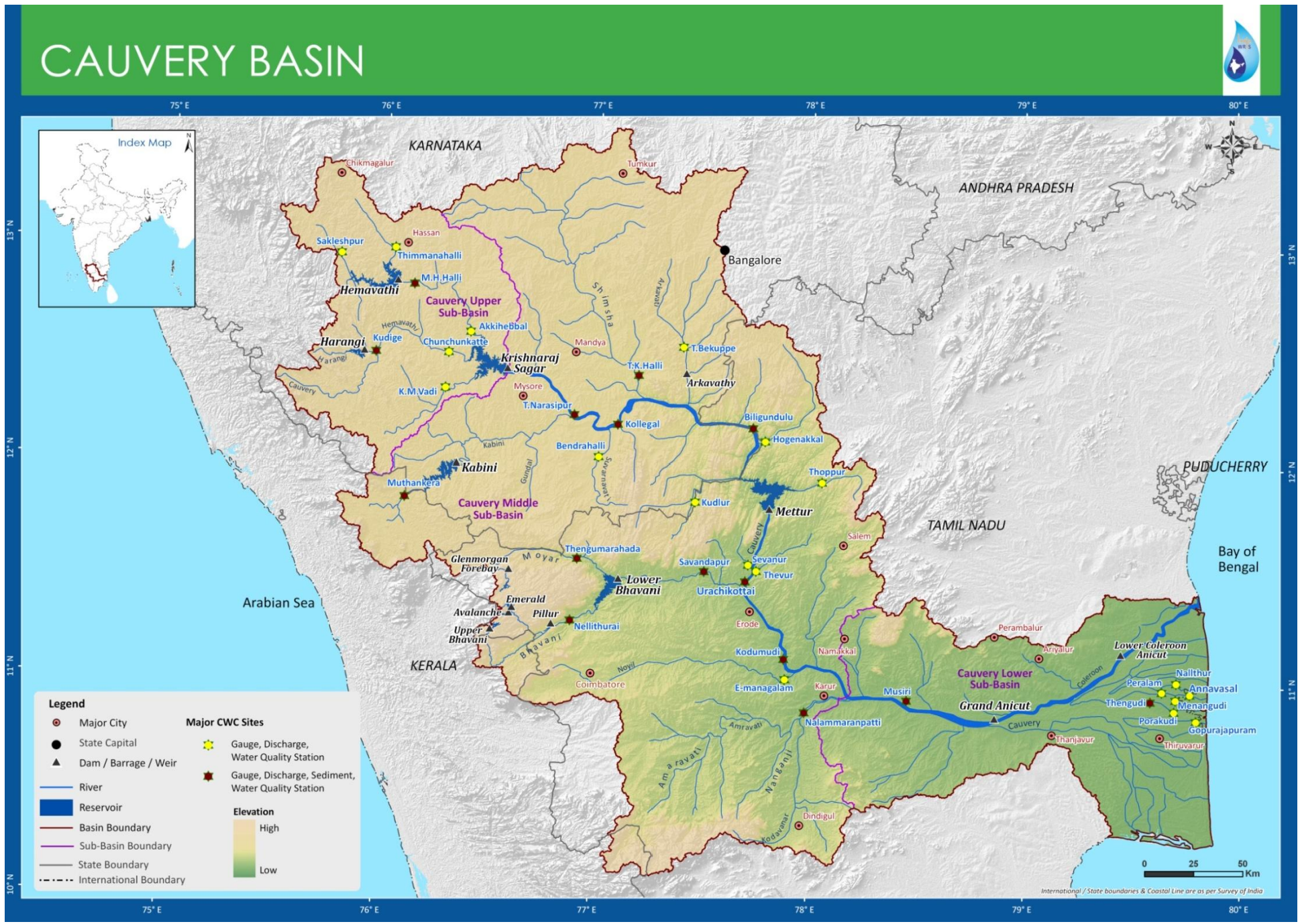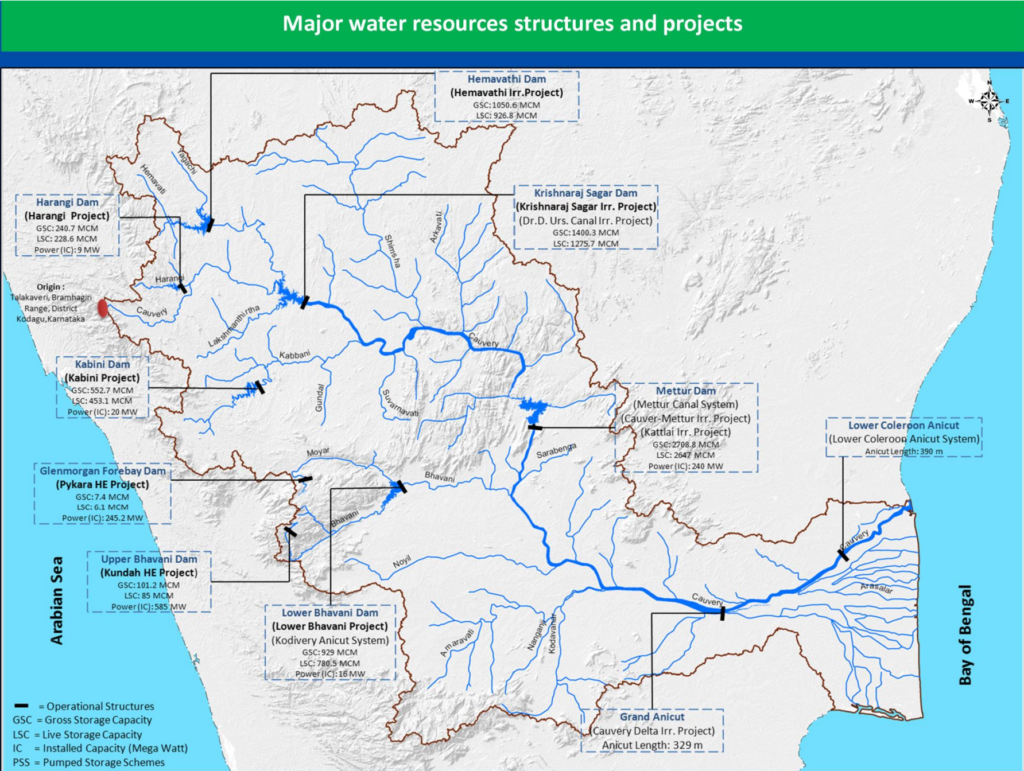The Union Jal Shakti Ministry stated that the Cauvery Water Management Authority has requested Karnataka to release water to Tamil Nadu
July 31 2023
In response to MP C.Ve. Shanmugam’s question (AIADMK), Union Minister of State, Bishweswar Tudu, informed the Rajya Sabha on Monday that the Cauvery Water Management Authority (CWMA) sent a letter on July 4, 2023, to the Karnataka government’s Additional Chief Secretary [Rakesh Singh]. The letter urged Karnataka to ensure the release of water in line with the final award of the CWDT (Cauvery Water Disputes Tribunal), as modified by the Hon’ble Supreme Court, for the current water year 2023-24.
The Minister also provided details about the water realization at Billigundulu on the inter-State border in the last three years. According to the Supreme Court’s judgement in February 2018, Karnataka was directed to release 177.25 thousand million cubic feet (tmc ft) of water annually at Billigundulu. The actual realizations were 211.315 tmc ft in 2020-21, 281.058 tmc ft in 2021-22, and 667.483 tmc ft in 2022-23.

History and background of Cauvery dispute
The Cauvery River is a significant river flowing through the Indian states of Karnataka, Tamil Nadu, Kerala, and Puducherry. It plays a crucial role in providing water for irrigation, drinking, and industrial purposes in these regions.
However, the water resources of the Cauvery River are limited, leading to a longstanding dispute between Karnataka and Tamil Nadu regarding the distribution of its water. This dispute has resulted in protests, legal battles, and even instances of violence in the past.
In 2018, the Supreme Court of India attempted to resolve the Cauvery water dispute by allocating specific water quantities to each of the four riparian states. Despite this order, the issue has not been fully resolved, and tensions persist between Karnataka and Tamil Nadu.
The Cauvery water dispute is a complex and ongoing issue, and finding a sustainable solution is challenging. Understanding the complexities of the dispute is essential for managing the river’s water resources effectively.
Key points about the Cauvery water dispute:
- The dispute has been ongoing for more than a century.
- The main states involved are Karnataka and Tamil Nadu.
- The dispute revolves around the allocation of water for irrigation, drinking, and industrial purposes.
- The Supreme Court of India issued an order to resolve the dispute, but its full implementation remains a challenge.
- The dispute requires a comprehensive and thoughtful approach, as there is no simple solution.
Union Jal Shakti Ministry
The Union Jal Shakti Ministry (JSM) is the central authority responsible for water resources in India. It was established in May 2019 by merging the Ministry of Water Resources, River Development, and Ganga Rejuvenation, and the Ministry of Drinking Water and Sanitation.
The JSM has an extensive scope of duties, which includes:
- Planning, developing, and managing water resources across India.
- Revitalizing the Ganga River and its tributaries.
- Ensuring access to safe drinking water for all households in the country.
- Promoting sanitation and hygiene.
- Implementing flood control and management measures.
- Monitoring and maintaining water quality.
- Addressing inter-state water disputes.
To tackle the water challenges India faces, the JSM has undertaken several initiatives, such as:
- The Jal Jeevan Mission, aiming to provide piped water to all households by 2024.
- The Namami Gange project, focused on cleaning the Ganga River and its tributaries.
- The Swajaldhara scheme, providing safe drinking water to rural households.
- The Nirmal Bharat Abhiyan, working towards universal sanitation coverage.
The JSM is also actively engaged in international efforts to address global water challenges, collaborating with organizations like the Global Water Partnership, the International Water Management Institute, and the World Bank.
The JSM’s significant achievements include providing piped water to over 100 million households through the Jal Jeevan Mission, successfully cleaning the Ganga River and its tributaries via the Namami Gange project, offering safe drinking water to over 20 million rural households with the Swajaldhara scheme, and attaining universal sanitation coverage through the Nirmal Bharat Abhiyan.
With a strong commitment to ensuring safe drinking water, sanitation, and addressing water scarcity and pollution, the JSM continues to lead efforts in water management at both national and global levels.
About Cauvery river
The Cauvery River, a significant waterway in India, flows through the states of Karnataka, Tamil Nadu, Kerala, and Puducherry. Spanning 805 kilometers (500 miles) in length, it covers a basin area of 81,155 square kilometers (31,320 square miles). Originating in the Western Ghats of Karnataka, it courses eastward through Karnataka and Tamil Nadu before finally emptying into the Bay of Bengal in Tamil Nadu.
This river serves as a crucial water source for irrigation, drinking water, and industrial purposes in the states it traverses. It holds great appeal as a tourist destination, with its delta housing numerous historically and culturally significant sites.
Being a perennial river, the Cauvery flows throughout the year, with water levels fluctuating seasonally. The monsoon season, from June to September, brings the river to its peak.
However, the Cauvery River has become a subject of contention between Karnataka and Tamil Nadu. For many years, these states have engaged in a legal battle over sharing its waters. Despite several orders from the Supreme Court of India attempting to resolve the dispute, a definitive solution is yet to be reached.
As a valuable resource for the people of India, managing the Cauvery River’s water sustainably requires collaboration among the four states it flows through.

Here are some intriguing facts about the Cauvery River:
- The Cauvery River holds immense religious significance in India and is revered as the goddess Cauvery.
- It is the origin of the fertile Kaveri delta, renowned as one of India’s most productive agricultural regions.
- The river boasts important historical and cultural sites like the town of Talakaveri, the Shivanasamudra Falls, and the Grand Anicut.
- Renowned for its picturesque beauty, the Cauvery River is a favored destination among tourists.
